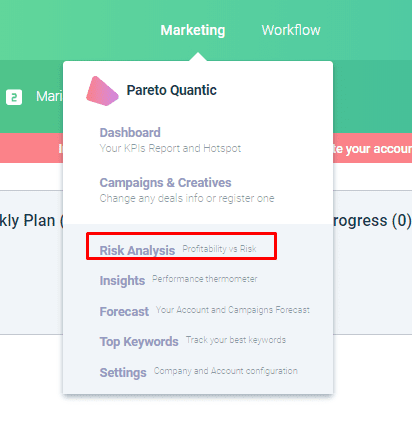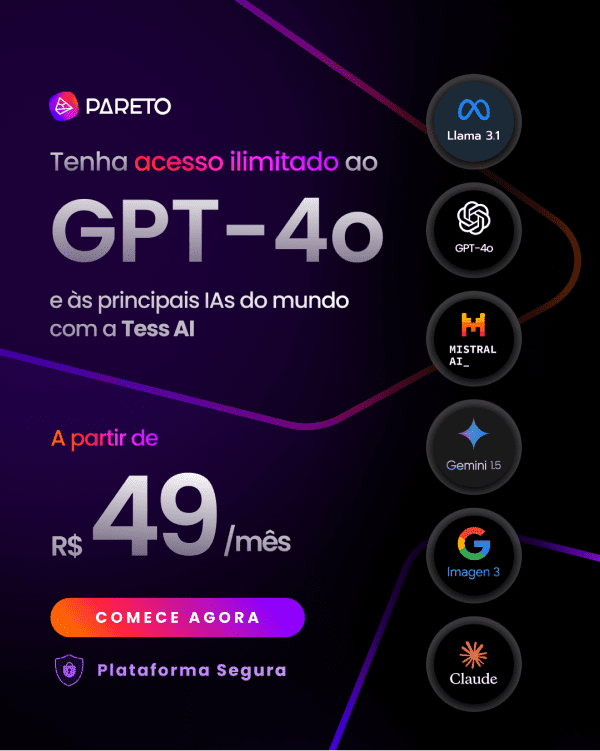Introduction
This article aims to introduce you to what you'll find in the "Risk Analysis" tab on our Pareto.io. This way, you'll be aware of the most important metrics for analyzing your Google Ads account!
This analysis was created by Pareto especially to present important information on account structure, expansion and optimization.
What is Pareto.io's Risk Analysis tab?
First, you can get to the Risk Analysis tab by clicking on the top menu of the platform. Click on "Marketing" and then "Risk Analysis". See the image below:

And what will you find in this Pareto.io tab? A lot!
The information you get from it allows you to analyze and come up with ideas for various points of improvement in your account. So, shall we explore it?
Risk Score
Pareto has created the award-winning Risk Score, based on financial market principles. With it, you can assess whether your account is well optimized and how much risk it is running.
Using our super algorithm, we calculate how well-structured the account is, based on different parameters that we will present later. Here's an example of a Pareto account:
"High risk" means low optimization. "Controlled risk" indicates high optimization and aggressive expansion, like investing in shares. On the other hand, "Low risk" means high optimization but little expansion, like investing in savings.
You'll also find a graph showing the evolution of your Risk Index over time. This way, you can understand how your account has evolved.
Red bars mean negative fluctuations, green bars show positive fluctuations and gray bars show constant index behavior.
Notice that below the graph there is a "ruler" where you can select the time period you want to observe on the graph. By hovering over the bars, you can see your Pareto Score for that date. =D
In addition, you can analyze each of the optimization possibilities behind the Risk Index! Take a detailed look at every opportunity to increase the profitability of your account!
What's behind the Risk Index?
Now that we know what the Risk Index means, how about understanding the metrics behind it?
This index is calculated from evaluations of almost 30 indicators, involving different categories. Through them we can find many opportunities to improve the account!
Here at Pareto, we consider some important categories of analysis: Account Structure, Cost Efficiency, Targeting, Ad Performance and Rank Quality.
Using the Pareto Radar Graph, you can quickly see which areas of your account are most vulnerable and which you have the most control over.
See the example below of the Pareto Radar graph from our own account. On the platform, you can see the values for each metric.
Important Categories and Indicators
Now let's talk a bit about the indicators that make up these categories of our Risk Index.
To see these indicators for your account in detail, simply select the desired category. This way, you can delve deeper and find out what needs to be improved in your account.
On the platform, you can analyze each metric we calculate to generate your Risk Index. Have fun finding every detail that can be optimized in your account to improve your results!
Our advanced algorithm provides different weights for each metric. To do this, it takes into account the importance of each one.
Category 1: Account Structure
Now on to the first major category. It assesses Account Structure.
Some indicators that influence this metric are Conversion Tracking and Attribution Model Enablement. In other words, whether your account is tracking conversions in the best possible way. And here at Pareto we are able to track the site very effectively!
Another 2 indicators on structure indicate how the campaigns are structured in the Pareto Structure and how efficient your Brand Campaign is.
In addition, other important indicators involve importing metrics from other analysis platforms, such as Search Console and Google Analytics. These are important for linking organic traffic data and various performance metrics related to the site.
Category 2: Cost Efficiency
Moving on to the next major category that makes up our Risk Index, we have Cost Efficiency.
One of the indicators in this section involves the efficiency of negating and activating search terms. It assesses how many search terms have already triggered your ads and how many of them are controlled by you.
It's important to have good control of the terms that activate your ads so you don't pay for unqualified clicks.
The second evaluates whether the account is using remarketing lists to improve the account's cost performance.
Read more: The 7 Best Remarketing Audiences for Google Ads
We also have the so-called Pareto Ratio, which assesses whether your account is balanced in terms of the proportion of spending on terms that do or don't convert.
Finally, the last one indicates the proportion of investment in broad keywords, given that this type of correspondence is not the most efficient.
Category 3: Segmentation
The next major category is Segmentation, which will show whether we are applying bid modifiers. Some of the ones evaluated are Age, Parental Status (i.e. whether or not the person has children), Gender, Location and Device (Mobile, Computer and Tablet).
In addition, we consider whether there is a schedule for ads with bid modifiers according to the time of day and day of the week.
The higher the score in this category, the more control you have over the account.
Read more in this article: What are Google Ads Bid Adjustments - Learn the Top 6
Category 4: Ad Performance
Another major category in our Risk Index measures Ad Performance.
The first of these considers whether the best performing ads are being prioritized through optimized rotation.
It also assesses whether there are any Ad Extensions. These add more relevance and increase your quality score. Some of the main Extensions are: Sitelinks and Featured Phrase.
Another important item is the ad experiments. These indicate how many of your ad groups have more than one ad. This makes it possible to carry out statistical tests to show which one is more efficient.
Category 5: Quality of Rank
Finally, we come to the Rank Quality category within our Risk Index.
Pareto is one of the few companies in the world to provide a numerical value for your account's Quality Score (calculated based on the Google Ads Quality Score). It will show you how well you are doing in keyword auctions compared to your competitors.
Other indicators in this category include the expected click-through rate, the relevance of the ad and the landing page experience.
Read more in: Google Ads Quality Score: What Is It and How to Improve It?
Conclusion
So, that was the "Risk Analysis" tab of Pareto.io. There, you'll find valuable information about your Google Ads account!
So, now that you know all the information available in the "Risk Analysis" tab of Pareto.io, go and have a look! That way, you'll have a good idea of what's being done on your account and what you can still work on. =D
If you want to know more about Pareto and Pareto.io, just check out our website!



